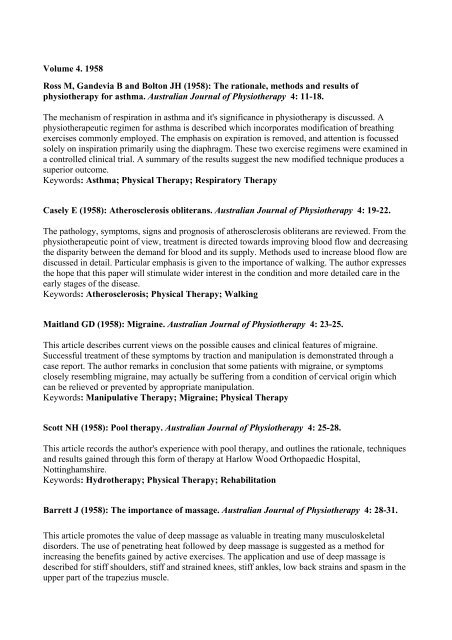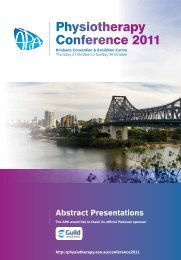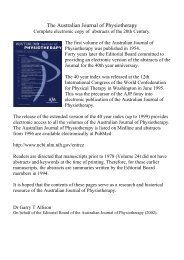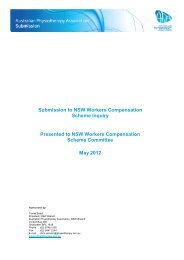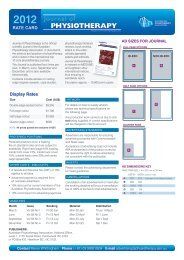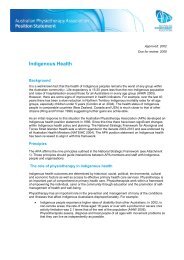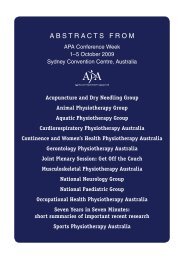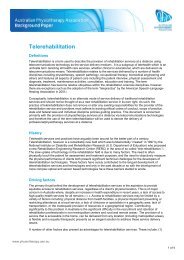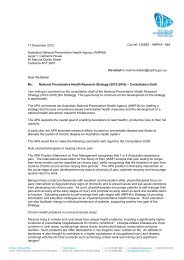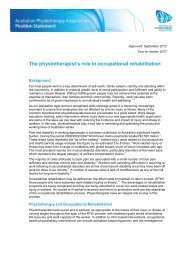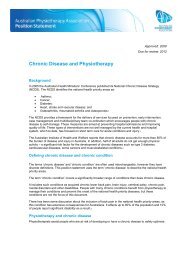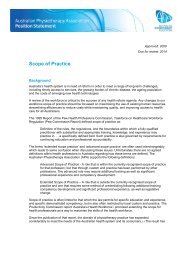The Australian Journal of Physiotherapy
The Australian Journal of Physiotherapy
The Australian Journal of Physiotherapy
You also want an ePaper? Increase the reach of your titles
YUMPU automatically turns print PDFs into web optimized ePapers that Google loves.
Volume 4. 1958<br />
Ross M, Gandevia B and Bolton JH (1958): <strong>The</strong> rationale, methods and results <strong>of</strong><br />
physiotherapy for asthma. <strong>Australian</strong> <strong>Journal</strong> <strong>of</strong> <strong>Physiotherapy</strong> 4: 11-18.<br />
<strong>The</strong> mechanism <strong>of</strong> respiration in asthma and it's significance in physiotherapy is discussed. A<br />
physiotherapeutic regimen for asthma is described which incorporates modification <strong>of</strong> breathing<br />
exercises commonly employed. <strong>The</strong> emphasis on expiration is removed, and attention is focussed<br />
solely on inspiration primarily using the diaphragm. <strong>The</strong>se two exercise regimens were examined in<br />
a controlled clinical trial. A summary <strong>of</strong> the results suggest the new modified technique produces a<br />
superior outcome.<br />
Keywords: Asthma; Physical <strong>The</strong>rapy; Respiratory <strong>The</strong>rapy<br />
Casely E (1958): Atherosclerosis obliterans. <strong>Australian</strong> <strong>Journal</strong> <strong>of</strong> <strong>Physiotherapy</strong> 4: 19-22.<br />
<strong>The</strong> pathology, symptoms, signs and prognosis <strong>of</strong> atherosclerosis obliterans are reviewed. From the<br />
physiotherapeutic point <strong>of</strong> view, treatment is directed towards improving blood flow and decreasing<br />
the disparity between the demand for blood and its supply. Methods used to increase blood flow are<br />
discussed in detail. Particular emphasis is given to the importance <strong>of</strong> walking. <strong>The</strong> author expresses<br />
the hope that this paper will stimulate wider interest in the condition and more detailed care in the<br />
early stages <strong>of</strong> the disease.<br />
Keywords: Atherosclerosis; Physical <strong>The</strong>rapy; Walking<br />
Maitland GD (1958): Migraine. <strong>Australian</strong> <strong>Journal</strong> <strong>of</strong> <strong>Physiotherapy</strong> 4: 23-25.<br />
This article describes current views on the possible causes and clinical features <strong>of</strong> migraine.<br />
Successful treatment <strong>of</strong> these symptoms by traction and manipulation is demonstrated through a<br />
case report. <strong>The</strong> author remarks in conclusion that some patients with migraine, or symptoms<br />
closely resembling migraine, may actually be suffering from a condition <strong>of</strong> cervical origin which<br />
can be relieved or prevented by appropriate manipulation.<br />
Keywords: Manipulative <strong>The</strong>rapy; Migraine; Physical <strong>The</strong>rapy<br />
Scott NH (1958): Pool therapy. <strong>Australian</strong> <strong>Journal</strong> <strong>of</strong> <strong>Physiotherapy</strong> 4: 25-28.<br />
This article records the author's experience with pool therapy, and outlines the rationale, techniques<br />
and results gained through this form <strong>of</strong> therapy at Harlow Wood Orthopaedic Hospital,<br />
Nottinghamshire.<br />
Keywords: Hydrotherapy; Physical <strong>The</strong>rapy; Rehabilitation<br />
Barrett J (1958): <strong>The</strong> importance <strong>of</strong> massage. <strong>Australian</strong> <strong>Journal</strong> <strong>of</strong> <strong>Physiotherapy</strong> 4: 28-31.<br />
This article promotes the value <strong>of</strong> deep massage as valuable in treating many musculoskeletal<br />
disorders. <strong>The</strong> use <strong>of</strong> penetrating heat followed by deep massage is suggested as a method for<br />
increasing the benefits gained by active exercises. <strong>The</strong> application and use <strong>of</strong> deep massage is<br />
described for stiff shoulders, stiff and strained knees, stiff ankles, low back strains and spasm in the<br />
upper part <strong>of</strong> the trapezius muscle.


